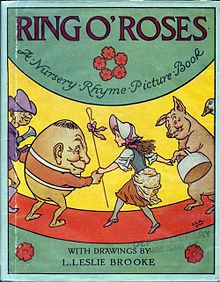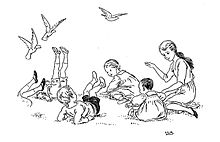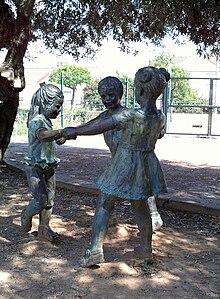Stripes
The Ringelreihen , also called Ringelreigen , is a game in which children hold hands and dance in a circle . Traditionally "Ringel, Ringel, Reihe" or another nursery rhyme is sung.
to form




In the German dictionary of the Brothers Grimm , under the heading " Ringelreihen" you can read: "The children hold hands so that they form a circle and dance a ringelreihen. as in medieval reien , it is sung. other rows of rings have more of the character of a game. the nursery rhymes sung in a row of rings begin with calls, like ringla ringla reiha. "
The folk song researcher Franz Magnus Böhme (1827–1898) introduces the chapter round dance and dance games in his book German children's song and children's game (1897) with this remark: “When the long-awaited spring comes, the spring games begin. These include above all the Ringelreihen (= Ringelreigen), which little girls jump while laughing and joking while singing. ”Then Böhme lists more than 200 nursery rhymes for the Ringelreihen (No. 41 to 260), many of them with melodies, some with more detailed explanations. He divides the rows of stripes into five categories according to the characteristics of movement or play:
- Rows of stripes with falling down
- Ring rows with reversal of the circle
- Rows of stripes with dissolution of the circle
- Ringed rows with choice (courtship, shepherd games)
- Rows of circles with pantomimes (imitation games)
Regarding the execution of the rows of stripes with falling down, Böhme writes: “The children take each other's hands and walk around in circles singing. At the end they all sit down on the floor at the same time, for which they laugh and start the game again. ”In a footnote, he notes that archaeologists like Müllenhoff and Mannhardt have interpreted bowing down or falling down as“ remnants of old sacrificial dances ”.
There are a number of variations in the arrangement of the children and their movements. You can walk in circles, but you can also run or jump. You can also just hold your hands and form a ring while standing. One or more children can stand in the middle of the ring. Instead of throwing themselves on the floor in a row of stripes in the "falling down" category, the children can sit down or crouch. If enough children play along, an outer and an inner ring can be formed.
Nursery rhymes
German
In the German-speaking world , the nursery rhymes sung in rows of stripes usually consist of a stanza with four short verses. Böhme handed down more than 200 ringed rows of songs and rhymes. Some are still sung today, especially these two (with minor textual differences if necessary):
Ringel, Ringel, row, there
are three of the children,
sit under the Holderbusch ,
everybody hush, hush, hush.
Ringlets, ringlets, roses,
yellow apricots,
blue violets, forget-me-nots,
all the children sit down.
In the third volume of the folk song collection Des Knaben Wunderhorn (1808) a more extensive version of the ringed row with the Holderbusch was published. Under the heading Ringelzeile song there is the explanation "The children dance in circles and suddenly sit down on the ground", then the lyrics:
Ringlets, ringlets, row!
When the children are three,
sitting on the Holderbusch,
all shouting musch, musch, musch, sit
down.
A woman sits in the ring,
with seven little children,
what do they like to eat?
Little fish.
What do you like to drink?
Red wine.
Sit down.
Böhme (1897) quotes the Ringelzeile song from Des Knaben Wunderhorn and two other versions with two stanzas. The vast majority of the Ringelzeile songs he has collected, however, are single-verse. Several dozen variants, which often also differ in dialect , begin with "Ringel, Ringel, Reihe" or a similar line. Two examples:
Ringele, Ringele, row,
we are our two,
we slip through a
holder stick, duseli, duseli, duk, duk, duk!
( Swabian )
Ringeli, Ringeli, Reihe,
D'Chind spoils i d'Maie. [= The children go into May]
She dances around the Rosestöck
And does all Bode-Bodehöck.
( Aargauian )
Some of the rhymes passed down by Böhme begin with “Ringel, Ringel, Rosenkranz” instead of “Ringel, Ringel, Reihe”. For example:
Ringlet-Ringel-Rosenkranz, put on
a pot of water,
tomorrow we want to wash,
small laundry, large laundry.
When the rooster
crows, we'll get up early,
the whole company is doing Kikeriki!
(From Berlin )
However, a nursery rhyme for ringlets does not have to contain the word "Ringel". One example of this is the series of rings that Hoffmann von Fallersleben recorded in 1843. Böhme assigns it to the "ringed rows with reversal of the circle" and explains that when the participants say "so so" they raise their hands and turn around several times:
What do we want to do
that we all laugh?
So we come so
seven years 'spun
seven years'
seven years won the clouds around,
then this and that turn around.
(From Barmen and Elberfeld )
English

Ring-a-ring o 'roses or ring-a-round the rosie is the common name for a row of rings in English. It corresponds to the first line of the most famous nursery rhyme sung along with it :
Ring-a-ring o 'roses,
A pocket full of posies,
A-tishoo! A-tishoo!
We all fall down.
The first lines speak of roses and bouquets of flowers ( posies ). The first line and the flower theme are reminiscent of stripes, rings, roses . In the fourth line (German: “We all fall down”) the children let themselves fall to the floor - it is therefore a row of stripes of the category “with falling down”. The text was first published in print in England in 1881.
In America, the first line is usually Ring-a-round the rosie and the third line is Ashes! Ashes! The language-playful third line can also read, for example, Husha, busha or similar. Twelve versions appeared in a collection from 1898, only one of which comes close to the text known today.
There are also more extensive versions with four stanzas. The first stanzas then end with We all fall down , the last stanza with We all get up again (“We all stand up again ”) or We all jump up again (“ We all jump up again ”); or the verses end alternately with We all fall down and We all jump up .
Ring-a-ring o 'roses is often written at the beginning with two hyphens, alternatively with four hyphens (mainly as a noun, corresponding to the word Ringelreihen ) or without hyphens: Ring a ring o' roses . There are also spelling variants such as Ringa ringa roses .
Italian
Girotondo is the Italian name for a row of rings . It is based on the first line of the nursery rhyme sung, which in one version reads as follows:
Giro giro tondo,
gira il mondo,
gira la terra,
tutti giù per terra.
In German:
Round, round, circle,
the world
is spinning, the earth is spinning,
everyone down on the ground.
The first line is formally (three two-syllable words, the first two as a repetition) and in terms of content very similar to the German "Ringel, Ringel, Reihe". The giro in the first line is ambiguous. It can be understood as a noun (“round”, “rotation”), but also as a verb (“I turn”).
Spanish
The most famous Spanish row of rings is the Corro de la patata ("Round dance of the potato"), also known as Corro de las patatas ("Round dance of the potatoes"). One version reads:
Al corro de la patata
comeremos ensalada,
como comen los señores:
naranjitas y limones.
Achupé, achupé,
sentadita me quedé.
The children sing (second line) that they will eat salad, followed by oranges and lemons on the fourth line. The children sit down on the last line (analogous to “I sat down”). The word sentadita is a childlike diminutive of sentado (literally “set”), with -a as a feminine ending. That is, this line fits when little girls sing it.
Word forms
Rows of rings, rows of rings
The first part of the word Ringel is a diminutive of Ring . Ringelreihen is a variant of the word Ringelreigen , which means "circle dance ". A round dance is not always danced in a circle; Round dancers can also form a chain or stand opposite one another in rows.
Grimm's German dictionary lists the key word Ringelreihen and states that Ringelreigen appears "less often" in the written language, which is still true today. Duden nonetheless uses Ringelreigen as a keyword and states that only the form Ringelreihen is used in Austria .
Row of stripes
Duden mentions Ringelzeile as a "related" word form, without giving further details. The word form Ringelzeile corresponds to the fact that the first line of the sung song is often "Ringel, Ringel, Reihe". Ringelzeile already appeared in Des Knaben Wunderhorn (1808), as part of the heading Ringelzeile-Lied . In common parlance, “dancing in a row of rings” is just as common as “dancing in a row of rings”. At the beginning of the song, the form "ring, ring, row" clearly outweighs "ring, ring, row".
literature
- Franz Magnus Böhme: German children's song and children's game. Breitkopf and Härtel, Leipzig 1897. Second book: Children's game , Chapter 2: Reigen and dance games , pp. 438–505 ( digitized version )
- Renate Sarr: Documentation nursery rhyme. Indexing of the song folders of the German Folk Song Archive in the Center for Popular Culture and Music. Group K XV: game songs, individual folders. Finding aid. Center for Popular Culture and Music, Freiburg 2014. 1096 pages ( PDF , 7.7 MB)
In this directory you can find numerous strings (with a total of thousands of variations) using the categorization above the respective song text: with search terms such as "Kreisspiele" and "Reversal of the circle" and "Dissolution of the circle".
Web links
- Ringelreihen on volksliederarchiv.de (search results for the word "Ringel")
Individual evidence
- ↑ a b rows of stripes, m.. In: Jacob Grimm , Wilhelm Grimm (Hrsg.): German dictionary . tape 14 : R - skewness - (VIII). S. Hirzel, Leipzig 1893, Sp. 999 ( woerterbuchnetz.de ).
- ^ A b Franz Magnus Böhme: German children's song and children's game. Breitkopf and Härtel, Leipzig 1897, p. 438 ( digitized version ).
- ^ Franz Magnus Böhme: German children's song and children's game. Breitkopf and Härtel, Leipzig 1897, table of contents ( digitized version ).
- ^ Franz Magnus Böhme: German children's song and children's game. Breitkopf and Härtel, Leipzig 1897, p. 446 ( digitized version ).
- ↑ Also quoted under the keyword Ringelreigen on volksliedarchiv.de
- ↑ a b See Ringel Ringel series , video on YouTube (0:36 min.). In this case, five girls hold hands and stand in a circle with three other girls standing in it. At the end of each stanza, the three girls crouch briefly in the middle while the others clap their hands.
- ↑ Example from Franz Magnus Böhme: German children's song and children's game. Breitkopf and Härtel, Leipzig 1897, p. 438 ( digitized version ). To dance game . No. 247 writes Boehme: "It will be a full circle in the middle of a child arises ..."
- ↑ See photography from Wiltshire in England (1942). In this case two children stand in the middle of the ring.
- ↑ See photography from Poggiomarino in Italy (2015): Ringelreihen mit Doppelkreis.
- ↑ Ringel, Ringel, Reihe , two versions at liederprojekt.org, with melody and audio file to listen to.
- ↑ See Ringel Ringel series , video on YouTube (0:36 min.). The girls sing the two versions as two stanzas. With slight textual deviations, in the first stanza: “Hollerbusch” instead of “Holderbusch”, “everyone screams” instead of “everyone does”; in the second stanza: "cherries, apricots" instead of "yellow apricots", "violets and forget-me-nots" instead of "violets blue, forget-me-nots".
- ↑ Ringelzeile song from Des Knaben Wunderhorn , Volume 3, at projekt-gutenberg.org
- ↑ a b Ringelzeile song from Des Knaben Wunderhorn , Volume 3, in the German Text Archive , with a digitized version of the original edition.
- ^ A b Franz Magnus Böhme: German children's song and children's game. Breitkopf and Härtel, Leipzig 1897, p. 439 ff. ( Digitized version ).
- ^ Franz Magnus Böhme: German children's song and children's game. Breitkopf and Härtel, Leipzig 1897, p. 443 ( digitized version ).
- ^ Franz Magnus Böhme: German children's song and children's game. Breitkopf and Härtel, Leipzig 1897, p. 454 ( digitized version ).
- ↑ a b A Short Analysis of 'Ring-a-Ring o' Roses' interestingliterature.com
- ↑ Ringel Rangel Rosen (1895) volksliederarchiv.de
- ↑ a b Ring a Ring o 'Roses allnurseryrhymes.com
- ↑ a b Ring a Ring O 'Roses (Ring Around The Rosie) nurseryrhymes.org
- ↑ See Ring-a-ring-a-roses parentingnation.in
- ↑ See video on YouTube (1:21 min.). In this case, falling down and jumping up is played alternately, corresponding to the alternating singing of We all fall down and We all jump up .
- ↑ Examples of the notation with four hyphens: ring-a-ring-o'-roses langenscheidt.com, ring-a-ring-o'-roses collinsdictionary.com
- ↑ Example for the spelling without hyphens: Ring a ring o 'roses ldoceonline.com
- ↑ Example: Ringa ringa roses mamalisa.com
- ↑ girotondo treccani.it
- ↑ Cf. Giro giro tondo coccolesonore.it (version with six stanzas)
- ↑ Al corro de la patata pequenet.com
- ↑ See sentadito in the English Wiktionary.
- ↑ Indication of the origin of Ringel at Duden online
- ↑ a b Duden online: Ringelreigen
- ↑ See example sentence for row of stripes at dwds.de.
- ↑ Renate Sarr: Documentation children's song. Indexing of the song folders of the German Folk Song Archive in the Center for Popular Culture and Music. Group K XV: game songs, individual folders. Finding aid. Center for Popular Culture and Music, Freiburg 2014 ( PDF ). “Ringel, Ringel, Reihe” appears eight times in the list of the beginnings of the song in its most famous form (pp. 3–11); the form "Ringel, Ringel, Serien" appears only as a variant and only twelve times out of around 200 listed variants of the most famous Ringelzeile song (pp. 115–124).





